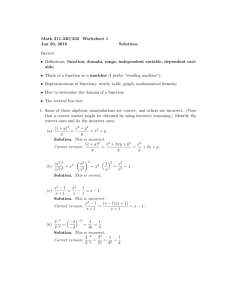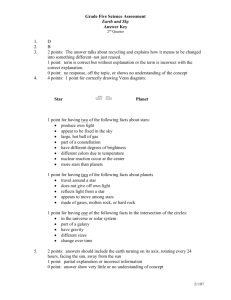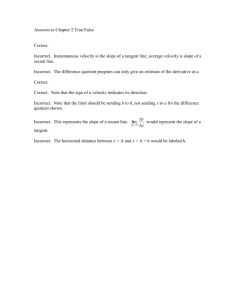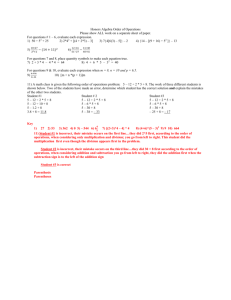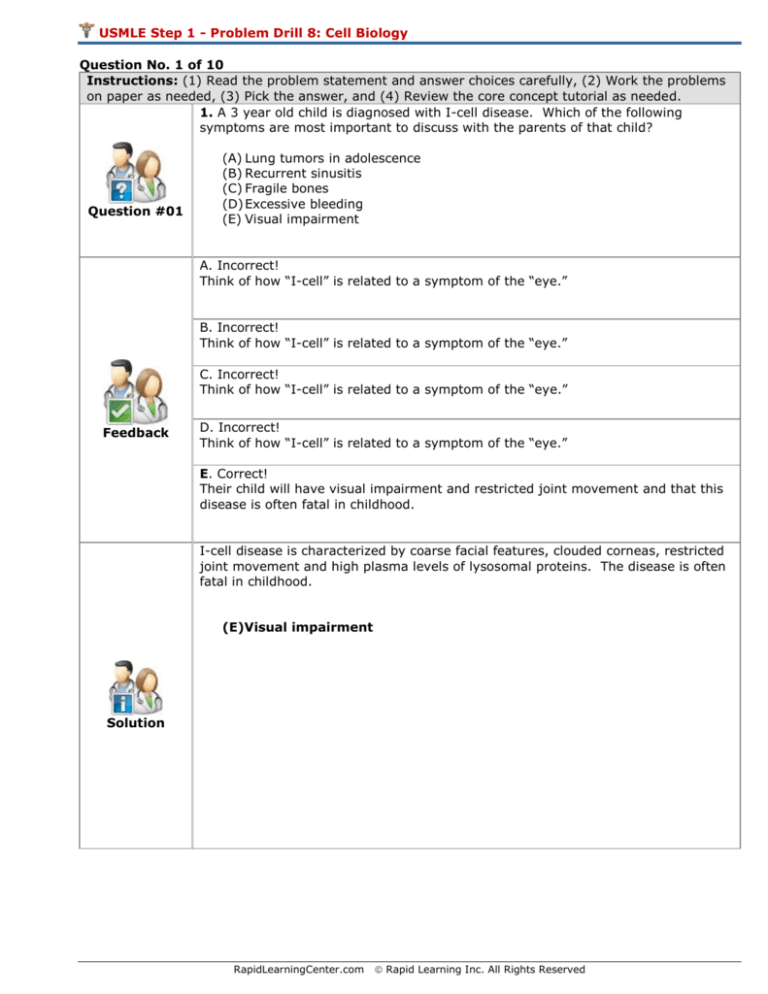
USMLE Step 1 - Problem Drill 8: Cell Biology
Question No. 1 of 10
Instructions: (1) Read the problem statement and answer choices carefully, (2) Work the problems
on paper as needed, (3) Pick the answer, and (4) Review the core concept tutorial as needed.
1. A 3 year old child is diagnosed with I-cell disease. Which of the following
symptoms are most important to discuss with the parents of that child?
Question #01
(A) Lung tumors in adolescence
(B) Recurrent sinusitis
(C) Fragile bones
(D) Excessive bleeding
(E) Visual impairment
A. Incorrect!
Think of how “I-cell” is related to a symptom of the “eye.”
B. Incorrect!
Think of how “I-cell” is related to a symptom of the “eye.”
C. Incorrect!
Think of how “I-cell” is related to a symptom of the “eye.”
Feedback
D. Incorrect!
Think of how “I-cell” is related to a symptom of the “eye.”
E. Correct!
Their child will have visual impairment and restricted joint movement and that this
disease is often fatal in childhood.
I-cell disease is characterized by coarse facial features, clouded corneas, restricted
joint movement and high plasma levels of lysosomal proteins. The disease is often
fatal in childhood.
(E)Visual impairment
Solution
RapidLearningCenter.com
Rapid Learning Inc. All Rights Reserved
Question No. 2 of 10
Instructions: (1) Read the problem statement and answer choices carefully, (2) Work the problems
on paper as needed, (3) Pick the answer, and (4) Review the core concept tutorial as needed.
2. In _____ cilia are immotile due to a defect in the structure of dynein.
Question #02
(A) Chédiak-Higashi syndrome
(B) Kartangener’s syndrome
(C) Ehlers-Danios syndrome
(D) I-cell disease
(E) Osteogenesis imperfecta
A. Incorrect!
Chédiak-Higashi syndrome arises from a defect in microtubule polymerization and
results in a decrease in phagocytosis.
B. Correct!
In Kartangener’s syndrome cilia are immotile due to a defect in the structure of
dynein.
C. Incorrect!
Ehlers-Danios syndrome arises from a defect in collagen synthesis.
Feedback
D. Incorrect!
I-cell disease arises when there is a failure to add mannose-6-phosphate.
E. Incorrect!
Osteogenesis imperfecta arises from a defect in collagen synthesis.
In Kartangener’s syndrome cilia are immotile due to a defect in the structure of
dynein. It results in male and female infertility, sperm are not motile,
bronchiectasis and recurrent sinusitis, as bacteria and other particles are not
pushed out, and it is associated with situs inversus.
(B)Kartangener’s syndrome
Solution
RapidLearningCenter.com
Rapid Learning Inc. All Rights Reserved
Question No. 3 of 10
Instructions: (1) Read the problem statement and answer choices carefully, (2) Work the problems
on paper as needed, (3) Pick the answer, and (4) Review the core concept tutorial as needed.
3. 90% of the total collagen found in the human body is ____.
Question #03
(A) Type
(B) Type
(C) Type
(D) Type
(E) Type
I
II
III
IV
V
A. Correct!
90% of the total collagen found in the human body is Type I, which is found in
bone, skin, tendon, dentin, fascia, cornea, and in late wound repair.
B. Incorrect!
Type II is found in the cartilage, vitreous body and nucleus pulposus.
C. Incorrect!
Type III is found in the skin, blood vessels, uterus, fetal tissue and granulation
tissue.
Feedback
D. Incorrect!
Type IV is found in the basement membrane or basal lamina.
E. Incorrect!
There is not a type V collagen.
In the human body collagen is the most abundant protein, it is extensively modified
and it acts to organize and strengthen the extracellular matrix. Type I, which
comprise 90% of the total collagen, is found in the bone, skin, tendon, dentin,
fascia, cornea, and in late wound repair. Type II is found in the cartilage, vitreous
body and nucleus pulposus. Type III is found in the skin, blood vessels, uterus,
fetal tissue and granulation tissue. Type IV is found in the basement membrane or
basal lamina.
(A)Type I
Solution
RapidLearningCenter.com
Rapid Learning Inc. All Rights Reserved
Question No. 4 of 10
Instructions: (1) Read the problem statement and answer choices carefully, (2) Work the problems
on paper as needed, (3) Pick the answer, and (4) Review the core concept tutorial as needed.
4. A 19 year old man describes trouble with his vision. You notice that the patient is
very tall and thin, with long fingers and limbs. You suspect he may have _____.
Question #04
(A) Ehlers- Danios syndrome
(B) I-cell disease
(C) Chédiak-Higashi
(D) Marfan’s syndrome
(E) Osteogenesis imperfecta
A. Incorrect!
Ehlers-Danios syndrome arises from a defect in collagen synthesis, primarily the
synthesis of type III collagen.
B. Incorrect!
I-cell disease is characterized by coarse facial features, clouded corneas, restricted
joint movement and high plasma levels of lysosomal proteins.
C. Incorrect!
Chédiak-Higashi syndrome arises from a defect in microtubule polymerization and
results in a decrease in phagocytosis.
Feedback
D. Correct!
Marfan’s syndrome is due to a defect in fibrillin.
E. Incorrect!
Osteogenesis imperfecta arises from a defect in collagen synthesis.
Elastin is an elastic protein found within the lungs, large arteries, elastic ligaments,
vocal cords, skin, bladder, elastic cartilage and ligamenta flava. Fibrillin is an
essential component of elastin, cross-linking of fibrillin is carried out by lysyl oxidase
to form rubber-like, elastic fibers. Marfan’s syndrome is due to a defect in fibrillin.
(D)Marfan’s syndrome
Solution
RapidLearningCenter.com
Rapid Learning Inc. All Rights Reserved
Question No. 5 of 10
Instructions: (1) Read the problem statement and answer choices carefully, (2) Work the problems
on paper as needed, (3) Pick the answer, and (4) Review the core concept tutorial as needed.
5. Enzyme inhibitors that are competitive will ____.
Question #05
(A) Have no effect on Vmax.
(B) Increase Vmax.
(C) Decrease Vmax.
(D) Have no effect on Km.
(E) Decrease Km.
A. Correct!
Competitive inhibitors will have no effect on Vmax.
B. Incorrect!
Competitive inhibitors will have no effect on Vmax.
C. Incorrect!
Competitive inhibitors will have no effect on Vmax.
Feedback
D. Incorrect!
Competitive inhibitors they will increase Km.
E. Incorrect!
Competitive inhibitors they will increase Km.
Enzyme inhibitors may be competitive or non-competitive. Competition refers to
competition between the normal substrate for the enzyme, and the inhibitor in
question. Competitive inhibitors will be: Similar to the natural substrate. May be
displaced by increasing concentrations of substrate. Bind the active site of the
enzymes. Have no effect on Vmax. But they will increase Km.
(A)Have no effect on Vmax.
Solution
RapidLearningCenter.com
Rapid Learning Inc. All Rights Reserved
Question No. 6 of 10
Instructions: (1) Read the problem statement and answer choices carefully, (2) Work the problems
on paper as needed, (3) Pick the answer, and (4) Review the core concept tutorial as needed.
6. A 39 year old man is diagnosed with gout. Which of the following therapies would
be appropriate?
Question #06
(A) Paclitaxel
(B) Colchicine
(C) Vincristine
(D) Vinblastine
(E) Griseofulvin
A. Incorrect!
Paclitaxel is used to treat breast cancer.
B. Correct!
Colchicine is used to treat gout.
C. Incorrect!
Vincristine is used to treat cancer.
Feedback
D. Incorrect!
Vinblastine is used to treat cancer.
E. Incorrect!
Griseofulvin is used to treat fungal infections.
Microtubule dynamics can be altered by drugs including,
mebendazole/thiabendazole, which is antihelminthic; paclitaxel, also known as taxol,
which is anti-breast cancer; griseofulvin, which is anti-fungal; vincristine/vinblastine,
which is anti-cancer and colchicine, which is anti-gout.
(B)Colchicine
Solution
RapidLearningCenter.com
Rapid Learning Inc. All Rights Reserved
Question No. 7 of 10
Instructions: (1) Read the problem statement and answer choices carefully, (2) Work the problems
on paper as needed, (3) Pick the answer, and (4) Review the core concept tutorial as needed.
7. A young child is brought to the emergency room with an injured foot. The parents
report their son was just kicking a playground type ball in the back yard when all of
a sudden he was crying with pain. They didn’t notice anything unusual happen while
he was kicking the ball. An x-ray shows several broken bones in the foot. It looks
like the ankle has an older healing fracture present also. The parent’s are shocked to
hear that bones are actually broken. You complete an exam of the boy and notice
his scleras are blue tinged, and his teeth are in poor condition. You also notice as
you question him about how he hurt his foot that he seems to be a little hard of
hearing. You suspect that this child may have _____.
Question #07
(A) Been a victim of child abuse.
(B) Type I osteogenesis imperfect.
(C) Taken a bad step due to his previously weakened ankle.
(D) Type II osteogenesis imperfecta.
(E) Osteopoikilosis.
A. Incorrect!
While child abuse is a serious concern and something to be alert for, in this case
with the additional symptoms of blue sclera, poor teeth, and hearing loss type I
osteogenesis imperfecta is a better answer.
B. Correct!
Signs and complication of osteogenesis imperfecta type I include, multiple fractures
occurring with little trauma, the fractures may occur during birth, and can be
confused with child abuse; blue sclera, due to the sclera being thinner than normal;
hearing loss, resulting from abnormal middle ear bones and dental imperfections,
resulting from a lack of dentin.
Feedback
C. Incorrect!
This choice does not explain the other symptoms of blue sclera, poor teeth, and
hearing loss.
D. Incorrect!
Type II osteogenesis imperfecta is apparent at birth. Typically it is fatal in utero, but
in rare cases the infant may survive delivery developing as a deformed dwarf with
normal mental function.
E. Incorrect!
Osteopoikilosis is characterized by dense calcification of the osseous tissue.
Solution
Osteogenesis imperfecta arises from a defect in collagen synthesis; there are a
variety of gene defects leading to different types of osteogenesis imperfecta. Type
II is typically fatal in utero. Type I is the most common, it is autosomal dominant
and is sometimes known as brittle bone disease. Signs and complication of type I
include, multiple fractures occurring with little trauma, the fractures may occur
during birth, and can be confused with child abuse; blue sclera, due to the sclera
being thinner than normal; hearing loss, resulting from abnormal middle ear bones
and dental imperfections, resulting from a lack of dentin.
(B)Type I osteogenesis imperfect.
RapidLearningCenter.com
Rapid Learning Inc. All Rights Reserved
Question No. 8 of 10
Instructions: (1) Read the problem statement and answer choices carefully, (2) Work the problems
on paper as needed, (3) Pick the answer, and (4) Review the core concept tutorial as needed.
8. A 5 year old boy exhibits easy bruising, a tendency to bleed, and extremely
flexible joints. You suspect he may have _____.
Question #08
(A) Ehlers- Danios syndrome.
(B) I-cell disease.
(C) Chédiak-Higashi.
(D) Marfan’s syndrome.
(E) Osteogenesis imperfect.
A. Correct!
The boy exhibits symptoms consistent with Ehlers- Danios syndrome.
B. Incorrect!
Think of a disorder linked to a defect in collagen synthesis.
C. Incorrect!
Think of a disorder linked to a defect in collagen synthesis.
Feedback
D. Incorrect!
Think of a disorder linked to a defect in collagen synthesis.
E. Incorrect!
Think of a disorder linked to a defect in collagen synthesis.
Ehlers-Danios syndrome arises from a defect in collagen synthesis, primarily the
synthesis of type III collagen. Signs and complications include hyperextensible skin,
a tendency to bleed and hypermobile joints.
(A)Ehlers- Danios syndrome
Solution
RapidLearningCenter.com
Rapid Learning Inc. All Rights Reserved
Question No. 9 of 10
Instructions: (1) Read the problem statement and answer choices carefully, (2) Work the problems
on paper as needed, (3) Pick the answer, and (4) Review the core concept tutorial as needed.
9. Vmax is the maximum rate of reaction, and is directly proportional to the _____.
Question #09
(A) Affinity of the enzyme for the substrate in question.
(B) Number of weak hydrogen bonds.
(C) Number of strong ionic bonds.
(D) Number of disulfide bridges.
(E) Enzyme concentration.
A. Incorrect!
Km indicates the affinity of the enzyme for the substrate in question.
B. Incorrect!
Hydrogen bonds are a type of folding pattern that hold a protein together providing
functional shape.
C. Incorrect!
Strong ionic bonds are a type of folding pattern that hold a protein together
providing functional shape.
Feedback
D. Incorrect!
Disulfide bridges are a type of folding pattern that hold a protein together providing
functional shape.
E. Correct!
Vmax is the maximum rate of reaction, and is directly proportional to the enzyme
concentration.
Many proteins act as enzymes, requiring an understanding of enzyme kinetics. V max
is the maximum rate of reaction, and is directly proportional to the enzyme
concentration. Km indicates the affinity of the enzyme for the substrate in question.
A lower Km indicates a higher affinity, and vice versa. When plotted on a logarithmic
scale, the slope of the line equals Km divided by Vmax. The farther the X intercept is
to the left, the weaker the Km. Similarly, the higher the Y intercepts, the lower the
Vmax. If the lines of two different drugs cross each other, these two drugs are
competing for the same enzyme. If the lines do not cross, they are not competing.
(E)Enzyme concentration.
Solution
RapidLearningCenter.com
Rapid Learning Inc. All Rights Reserved
Question No. 10 of 10
Instructions: (1) Read the problem statement and answer choices carefully, (2) Work the problems
on paper as needed, (3) Pick the answer, and (4) Review the core concept tutorial as needed.
10. A 45 year old woman is diagnosed with breast cancer. Which of the following
therapies would be appropriate?
Question #10
(A) Paclitaxel
(B) Colchicine
(C) Vincristine
(D) Vinblastine
(E) Griseofulvin
A. Correct!
Paclitaxel is used to treat breast cancer.
B. Incorrect!
Colchicine is used to treat gout.
C. Incorrect!
Vincristine is used to treat cancer.
Feedback
D. Incorrect!
Vinblastine is used to treat cancer.
E. Incorrect!
Griseofulvin is used to treat fungal infections.
Microtubule dynamics can be altered by drugs including,
mebendazole/thiabendazole, which is antihelminthic; paclitaxel, also known as taxol,
which is anti-breast cancer; griseofulvin, which is anti-fungal; vincristine/vinblastine,
which is anti-cancer and colchicine, which is anti-gout.
(A)Paclitaxel
Solution
RapidLearningCenter.com
Rapid Learning Inc. All Rights Reserved


